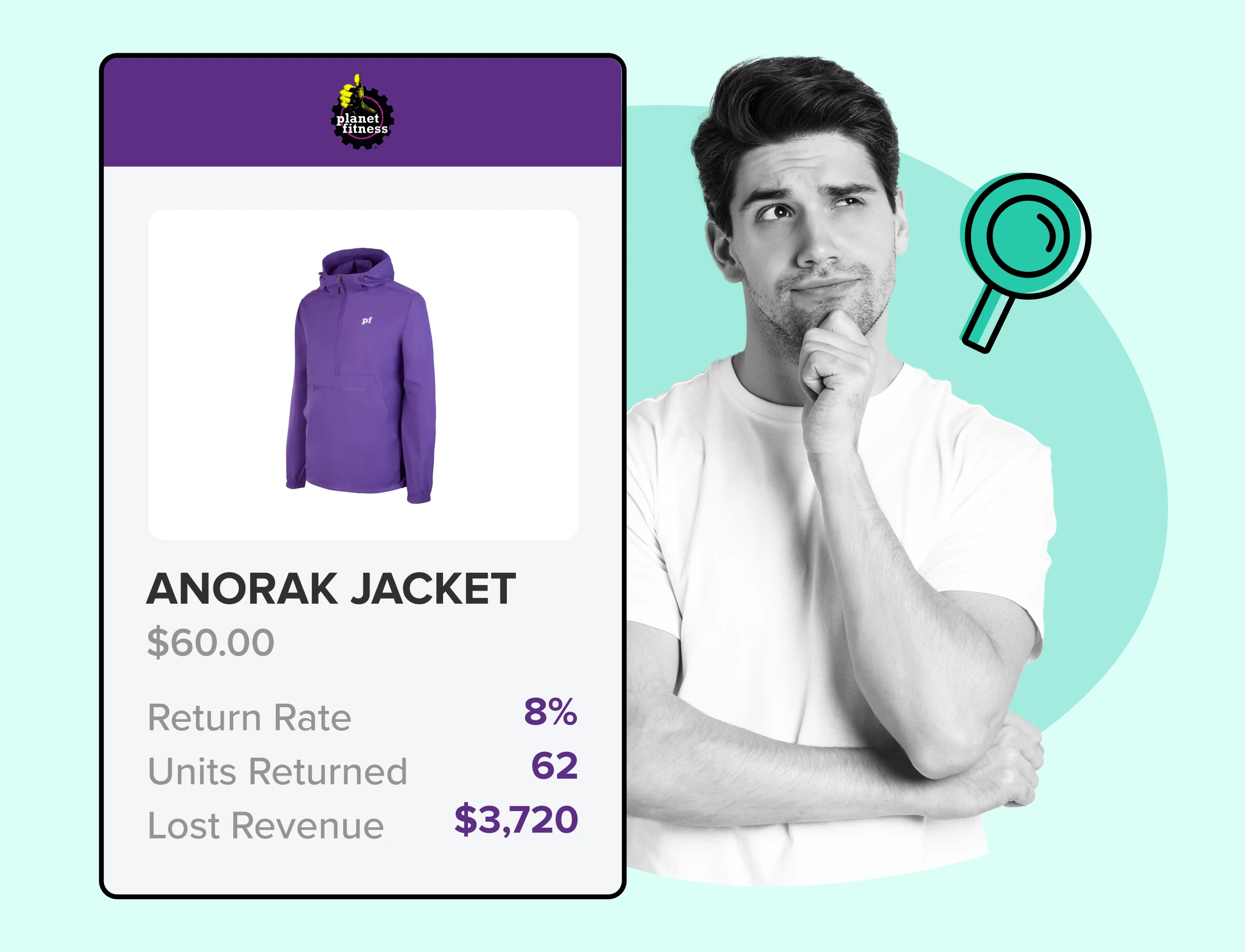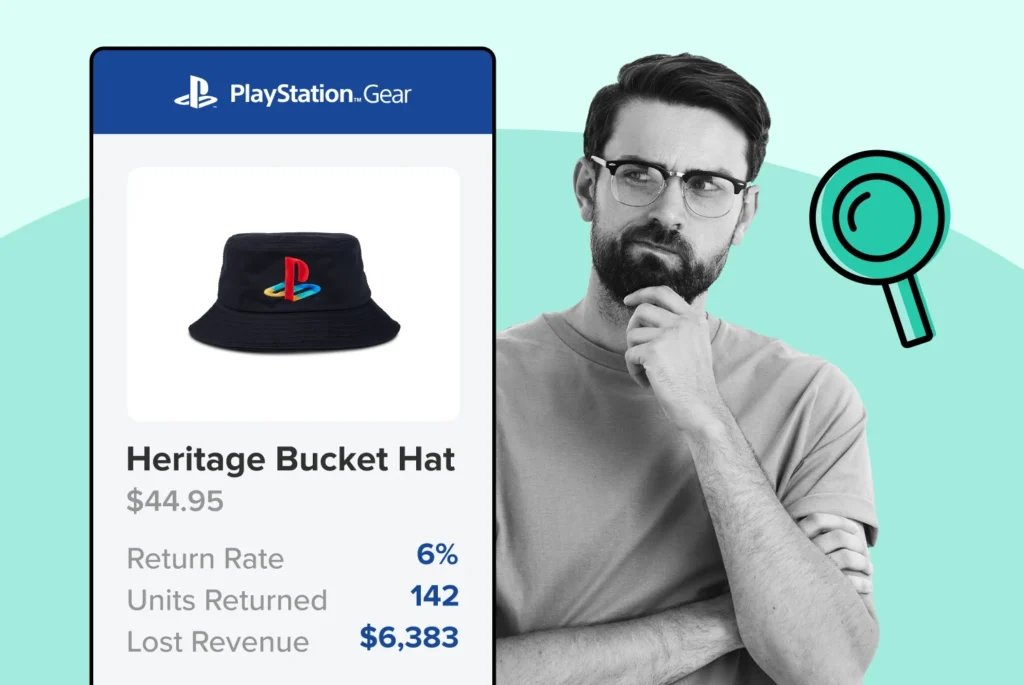
Top Strategies for Preventing Ecommerce Return Fraud Effectively
Concrete strategies for preventing ecommerce return fraud: from strengthening your return policy to leveraging technology and analytics!
Boost customer experience and reduce support tickets
Realtime order and shipment tracking
Proactive order and shipping notifications
Predictive pre-purchase estimated delivery dates
Self-Serivce branded order tracking
Effortless experience delivered
Make returns profitable and delight customers
Flexibility to define any return destinations & conditions
Simplify returns for your customers and team
Incentivize exchanges over returns
Returns management made easy for your team
Understand why your customers are returning
Unify the online and the in-store experience
Hassle-free pickup experience for customers
In-Store Dashboard to keep operations streamlined
In-Store and Online orders unified
Drive foot-traffic to your stores
Boost customer experience and reduce support tickets
Realtime order and shipment tracking
Proactive order and shipping notifications
Predictive pre-purchase estimated delivery dates
Self-Serivce branded order tracking
Effortless experience delivered
Make returns profitable and delight customers
Flexibility to define any return destinations & conditions
Simplify returns for your customers and team
Incentivize exchanges over returns
Returns management made easy for your team
Understand why your customers are returning
Unify the online and the in-store experience
Hassle-free pickup experience for customers
In-Store Dashboard to keep operations streamlined
In-Store and Online orders unified
Drive foot-traffic to your stores
Find the answer to all your questions
Explore the most comon questions about WeSupply
Calculate the ROI that WeSupply can bring you
Request a no strings attached review of your current shopping experience and missed conversion opportunities
Take a step by step trip through our functionality to see how we can improve your ecommerce processes.
Read actionable articles on how to optimize your post-purchase experience and decrease support tickets
Get inspired by stories of how our customers implemented an effortless post-purchase experience
A Deep Dive into Top Companies' Order Tracking & Returns Strategy
Wondering if WeSupply is a good fit for you? Read through our use cases to see how we can help you increase conversion & improve CX!

Navigating the significance of return metrics is crucial for businesses aiming to enhance customer satisfaction and operational success. Straightforwardly, this article will guide you through the different return metrics, explain their importance, and show how you can leverage them to fine-tune your business strategy and drive sustainable growth.
Return metrics extend far beyond simple return rates, providing businesses with valuable insights into product quality, customer satisfaction, operational health, and financial impacts that can influence strategic decision-making.
Key return metrics include a variety of specific measures such as refund rate, exchange rate, product return rate, time-to-return, repeat return rate, and return cost, each offering unique perspectives on business performance and customer interactions.
Optimizing the return process involves leveraging technology for efficient monitoring, understanding the psychology of returns to foster customer loyalty, and creating positive return experiences to improve customer satisfaction and retention.
WeSupply streamlines your return process to enhance profitability and customer satisfaction, offering deep insights into return metrics. It identifies frequent return reasons, improves product offerings through SKU-level analytics, and boosts customer retention with seamless exchanges. Key features include customizable return policies, proactive notifications, self-service returns, and integration with review platforms for comprehensive feedback management. Ready to transform your returns into growth opportunities? Get started with WeSupply today!
Return metrics are more than just a gauge of how often products are being returned. They provide a wealth of other information crucial for businesses. For example, a high return rate could point towards issues with product quality, while a low return rate might indicate high customer satisfaction. Above all, return metrics can guide businesses to make strategic decisions to enhance their product performance and improve customer interactions.
Such valuable insights make return metrics key tools for businesses. They are like compasses, guiding businesses towards better performance and improved customer satisfaction. Investing time and resources in understanding and utilizing these metrics can lead to significant returns in the form of higher customer loyalty, better brand reputation, and ultimately, increased profitability.
While the return rate is undoubtedly a crucial metric, it is essential to explore beyond this basic measure. A bouquet of return metrics awaits us, each providing unique insights into product performance and customer interactions. These metrics range from the refund rate to the repeat return rate, each shedding light on different facets of a business’s performance.
Return metrics are akin to vital signs in healthcare – they shed light on the health of your business. Monitoring these metrics can help identify trends, pinpoint areas for improvement, and highlight potential issues. For example, a sudden spike in return rates could signal product quality or design issues, which may need immediate attention.
However, selecting the right metrics can sometimes be a challenge. With a plethora of data available, it’s easy to get lost in the numbers. It’s crucial to focus on meaningful metrics that provide actionable insights and avoid vanity metrics that do not impact business outcomes.
A balanced approach would involve tracking both leading and lagging indicators to predict future performance and assess past performance respectively.
Understanding the language of return metrics is crucial to harnessing their power. The return rate, for example, is a simple yet crucial metric. It is determined by the proportion of total orders that are returned. This metric can be further refined into the product return rate, which tracks the percentage of a specific product that is returned. This distinction allows businesses to pinpoint issues with particular items.
The time-to-return is another vital metric. It measures the average duration between purchase and return, indicating how quickly customers realize their dissatisfaction. The refund rate, on the other hand, reveals the percentage of returns that result in refunds.
The return cost includes expenses related to:
Shipping
Restocking
Handling
Losses from revenue and sales
It gives a comprehensive view of the financial impact of returns. Each of these metrics shines a light on different aspects of a business, providing a more nuanced understanding of performance and customer interactions.
The cash return rate is a significant indicator that can reflect the financial health and stability of a business. It reveals the effectiveness of a company’s investment allocations and the efficiency of its operations. A high return rate may imply issues with product quality or customer dissatisfaction and can result in increased costs or reduced profitability for the business.
Moreover, the return rate can be utilized as a performance management tool. Businesses can use it to compare the performance of different investment projects or to assess the impact of not making a particular investment. By scrutinizing the return rate, businesses can make informed decisions that contribute to their strategic goals.
WeSupply offers comprehensive analytics to enhance your understanding and management of product returns, diving deep into essential return metrics to optimize your business and increase profits. Here’s how WeSupply can be instrumental:
SKU Level Insights: Quickly determine specific return reasons at the SKU level, including attributes like color, quality, and size.
Optimize Operations: Streamline processes and policies to improve profit margins, and understand the financial impact of returns and exchanges.
Increase Customer Value: Analyze returns to understand customer dissatisfaction and enhance customer lifetime value.
Measure Financial Impact: Access detailed analytics on the revenue lost to returns and the cost of returns to develop effective strategies.
Actionable Data: Utilize real-time return shipping analytics and BigQuery integration for operational efficiency and quick decision-making.
These features enable businesses to recover otherwise lost revenue and better meet customer needs. Ready to transform your returns experience? Book a demo with WeSupply today and see how deep insights can drive your profits and customer satisfaction!
Evereve, a boutique chain with over 93 locations, encountered significant challenges when the COVID-19 pandemic shifted consumer behavior towards online shopping, leading to a surge in returns. This was particularly problematic as return rates in online apparel sales can reach as high as 50%. Evereve’s solution was to revolutionize their returns management by implementing WeSupply’s integrated technology platforms, including Magento and Custom API integrations like Zendesk and Celerant. This transition enabled automated, streamlined returns processes focused on proactivity, self-service, and flexibility. The result was a dramatic improvement in operational efficiency, reduced costs, and enhanced customer loyalty by transforming the returns process into a positive experience. Interested in learning how EVEREVE turned a return dilemma into a strategic advantage? Explore the details in the full case study.
While understanding key return metrics is crucial, it’s equally essential to broaden your metrics toolbox. This is where additional return metrics like:
refund rate
exchange rate
product return rate
time-to-return
repeat return rate
return cost
come into play. These metrics can provide more profound insights into business strategies and customer satisfaction, helping businesses navigate the complex landscape of e-commerce and retail.
Refund rate is a critical metric in e-commerce, representing the percentage of total orders that are returned by customers for a refund. It can provide valuable insights into product quality and customer service. A high refund rate may indicate issues with product quality or dissatisfaction with customer service, suggesting areas that require improvement.
Keeping the refund rate within acceptable limits is paramount for e-commerce businesses. Mitigating high refund rates can be achieved by enhancing product quality, improving customer service, and implementing a clear and customer-friendly return policy.
WeSupply empowers businesses to enhance product quality and reduce refund rates through detailed SKU-level returns analytics. By identifying the reasons for returns across different products and variants, such as color, quality, and size, companies can make informed adjustments to sizing charts, update product images, and enrich product descriptions based on customer feedback. This targeted approach not only improves the accuracy of product listings but also helps in gathering essential customer insights to refine product offerings and increase customer satisfaction.
Exchange rate, or the ratio of exchanged orders to total returned orders in the same period, is another crucial metric. Offering favorable exchange rates can be an effective tool for customer retention, as it provides customers with the flexibility to choose an alternative product rather than requesting a refund.
Retention management is less costly compared to acquiring new customers and can also enhance the customer’s lifetime value while reducing acquisition costs. By offering a simple exchange process and leveraging customer data for personalized strategies, businesses can significantly boost their customer retention rates.
WeSupply transforms the exchange process into a powerful customer retention tool by ensuring a seamless shopping experience similar to your website. By facilitating easy exchanges and offering refunds in the form of store credits or gift cards, WeSupply encourages customers to shop again, potentially increasing their order value. This strategy not only incentivizes customers to opt for exchanges over returns but also plays a crucial role in enhancing customer lifetime value and building a lasting relationship with your brand.
The product return rate is a key metric that can guide businesses in targeted product improvements. It indicates how frequently customers return items purchased from an online store, providing insights into product quality and customer satisfaction.
Reducing product return rates can involve:
Implementing a clear return policy
Providing detailed product descriptions
Keeping customers informed about returns
Leveraging customer reviews
Encouraging exchanges over returns
By closely monitoring the product return rate, businesses can identify products that need improvement and take steps to enhance their quality.
WeSupply leverages advanced return metrics and integration with leading review platforms to help businesses understand and reduce product return rates through targeted product improvements. By analyzing specific return reasons at the SKU level, companies can make precise adjustments to their products and policies.
Key Features:
SKU Level Returns Analytics: Identify and address return reasons related to color, quality, and size at a granular level.
Returns Tracking: Provide customers with the ability to easily track their returns and check status updates with a few clicks.
Integrations with Review Platforms: Utilize integrations with platforms like Loox, Judge.me, Yotpo, Okendo, Junip, and Reviews.io to collect and leverage customer feedback for product enhancement and reduced return rates.
Time-to-Return is another vital metric. It measures the average duration between the purchase and the return of a product, indicating the speed at which customers decide to return items. In the world of SaaS businesses, the concept of Time to Value (TTV) is crucial for customer satisfaction and retention. TTV measures the amount of time it takes for a customer to perceive the value from a product.
A brief TTV can lead to increased customer loyalty as customers quickly see the worth of the product shortly after purchase, while a lengthy TTV may cause higher churn rates. By understanding and optimizing TTV, businesses can significantly improve their customer satisfaction levels.
The repeat return rate is a crucial metric that calculates the percentage of returns from repeat customers. It provides valuable insight into customer loyalty and satisfaction with a business’s products or services. It can provide insight into customer loyalty and repeat purchase behavior. Loyal customers are more likely to make repeat purchases, and businesses with loyalty programs or other retention strategies can bolster customer loyalty.
A well-handled returns process has been shown to encourage customers to make repeat purchases, enhancing their loyalty to the brand. By providing efficient returns processing, businesses can significantly increase the chances of customers returning to make future purchases.
The cost of returns is another significant factor to consider. It includes expenses related to shipping the item back, processing the return, and potentially restocking fees. Handling these costs can be a significant financial burden due to the loss of revenue and costs associated with processing returns, such as shipping costs, restocking fees, and inspection and repackaging.
Preventing returns through clear product descriptions, accurate sizing information, and well-communicated return policies can help reduce return costs. Efficiently recovering items through quicker returns and optimizing the reverse logistics process can lead to better planning and capital utilization for retailers.
WeSupply offers robust return analytics to help businesses effectively manage the financial impact of returns. By delivering data-driven insights, WeSupply enables eCommerce companies to assess the cost of returns, revenue lost due to returns, and overall return rates. This comprehensive understanding allows businesses to identify the root causes of returns by region and product, facilitating the development of more effective strategies to minimize costs and enhance revenue. This strategic approach not only reduces return rates but also optimizes return policies and product offerings for better financial outcomes.
Returns Analytics for eCommerce Business
Understand why your customers are returning: Identify the most returned products, Understand why those products are returned, Identify which customers are serial returners, Reduce Return Rate with Actionable Insights, Returns data available in BigQuery.
Before we proceed, let’s pause and reflect on the financial implications of returns. Returns can significantly impact a business’s cash flow, net operating income, and net present value.
The following sections will delve deeper into these concepts, providing a more nuanced understanding of the financial impact of returns.
When customers return products, it can disrupt a company’s cash flow and affect the cash on cash return. This often results in a delay in revenue recapture and requires additional resources to process the returns. Companies may face a strain on their cash flow when managing a high volume of returns, as it can tie up funds that could have been invested elsewhere or used to cover other operational costs.
Understanding how returns affect a company’s cash flow is vital for financial health. Positive cash flow can enable a company to invest in growth opportunities, which may lead to a higher return on capital, while negative cash flow can lead to liquidity issues and decrease return on capital.
The financial impact of returns can extend to a company’s net operating income. Returns can lead to increased costs for logistics, restocking, and potential loss of sales revenue. Returns can increase costs relating to goods sold and operating expenses, which may result in a lower net operating income, thus affecting overall business profitability.
Net Operating Income (NOI) is a critical metric used to evaluate the profitability of income-generating investments, such as real estate investment properties, prior to accounting for financing or tax costs. An increase in the property’s net operating income can be achieved by raising property revenue streams such as rents and fees, and by reducing necessary operating expenses. Understanding net income can provide a clearer picture of the overall financial performance of an investment property.
Adjustments made to return policies and processes can have long-term financial consequences, influencing the net present value by affecting expected future cash flows and profitability. Net present value (NPV) is a financial metric used to evaluate the profitability of an investment by calculating the difference between the present value of cash inflows and the present value of cash outflows, taking into account the cash invested.
NPV calculations use a discount rate to adjust for the time value of money, with projects having a positive NPV often considered a worthwhile investment. Adjusting return policies and processes can be evaluated by analyzing their projected cash flows and determining if the resulting NPV is positive.
Return metrics can have different implications for brick-and-mortar retailers compared to online retailers. For instance, physical stores often face space constraints and in-person customer service requirements that affect their return processes. Online retailers, on the other hand, may encounter distinct challenges with returns, such as:
the potential for higher return rates due to customers not being able to physically evaluate products before purchase
the need for efficient shipping and logistics to handle returns
the importance of clear return policies and processes on their website
Understanding these differences can help retailers tailor their return strategies to best meet the needs of their specific business model.
While physical stores offer immediacy for customer purchases and often see higher spending per visit, online retail allows for a variety of marketing tools like product badges, display banners, and customer reviews that can influence consumer purchasing decisions.
In this era of convergence, retail businesses need to adapt their return processes to suit their mode of operation, whether online or brick-and-mortar.
As we delve deeper into the world of return metrics, it’s essential to consider them against other investment considerations. The following sections will compare return metrics against other investment considerations and discuss the importance of ROI as the ultimate performance measure.
When investing in alternatives like private equity, investors often prioritize potential returns. However, they must also assess risks and the illiquidity of such investments, which can affect the final ROI. Return on investment (ROI) is used to evaluate the potential profitability of investments by comparing the net profit earned from an investment to its initial investment. One important metric to consider in this context is the equity multiple, which can provide additional insight into the overall performance of an investment.
Investors can use ROI to compare different investments on a like-for-like basis, and to evaluate whether an investment is growing, shrinking, or stagnating. However, ROI does not consider the time value of money, which can impact the assessment of an investment’s efficiency, especially when comparing investments over different time periods. As a result, investors commonly seek alternative metrics like Net Present Value (NPV) or internal rate of return (IRR) for a more comprehensive analysis.
The importance of ROI as a performance measure lies in its ability to offer a concrete and measurable way to assess investment efficiency and profitability, commonly expressed as a percentage. A good ROI is context-dependent, with different industries having varying averages. For instance, the average return for the S&P 500 is considered good at over 10.5 percent.
In the context of small businesses, most business experts recommend seeking an ROI between 15 and 30 percent, although large corporations may be content with an ROI of 10% or even less due to lower relative risk. Thus, ROI provides a simple summary of a stock’s or company’s performance and is widely used due to its success in quantifying efficiency and profitability.
By now, we’ve delved into the depths of return metrics and their importance in business strategy. The next step is to optimize the return process for maximum ROI. This involves:
Leveraging technology to track and analyze return metrics
Understanding the psychological aspect of returns
Creating strategies for a positive return experience
Technology can play a crucial role in streamlining the analysis of return metrics. By automating data collection from various sources like marketing, sales, and operations, and integrating it into a centralized system, businesses can efficiently track and analyze return metrics.
Cloud-based platforms, interactive dashboards, visualizations, and automated systems can improve the efficiency of return metrics monitoring. They can speed up the return process, offer real-time tracking, and provide immediate confirmation of return requests, promoting efficiency and customer satisfaction.
The psychological aspect of returns is often overlooked but plays a significant role in customer loyalty. An impressive 95% of customers indicate that their future shopping decisions are influenced by the way a brand handles returns.
Businesses that exceed customer expectations, especially during the return process, can enhance customer satisfaction and foster loyalty. Personalized and positive interactions with customers during the return process can strengthen the emotional connection and lead to repeat business.
Creating a positive return experience is pivotal for improving customer satisfaction and retention. Technology can foster a positive return experience by enabling businesses to quickly respond to customer feedback and continuously optimize return strategies.
Clear return policies, offering multiple return options, and excellent customer service are strategies to improve customer satisfaction and retention. A positive returns experience can serve as a competitive differentiator in the crowded eCommerce marketplace.
WeSupply optimizes the return process to maximize ROI by creating a seamless, branded experience that enhances customer loyalty and operational efficiency. Here’s how WeSupply streamlines returns for better business outcomes:
Buy Online, Return In Store: Offer the convenience of in-store returns for online purchases, improving customer satisfaction and reducing processing time.
Proactive Notifications: Utilize high-engagement post-purchase email and SMS notifications to keep customers informed and engaged, potentially including personalized deals.
Advanced Returns Tracking: Enable customers to easily track their returns and access status updates anytime, enhancing transparency and trust.
Flexible Returns Rules: Tailor your return policies to accommodate various scenarios, making the process more customer-friendly and less restrictive.
Self-Service Returns: Empower customers with a self-service portal, significantly reducing administrative overhead and improving the return experience.
Speed up returns process
Book a quick call with our experts to see how WeSupply’s self-service returns makes it super easy for your customers to return anything, anytime – without needing to submit customer support tickets or call in!
Comprehensive Returns Analytics: Gain insights into return patterns, identify the most returned products, and understand customer behaviors to reduce return rates effectively.
Logistics and Order Flow Analytics: Leverage detailed analytics to continuously refine and optimize the entire order and return lifecycle, from shipment to final delivery and return processing.
By leveraging these features, WeSupply not only improves the returns process but also significantly impacts customer retention and overall satisfaction, driving higher ROI for businesses. Maximize your returns strategy! Use our ROI Calculator to see how WeSupply can boost your efficiency and profitability.
As we look towards the future, return metrics are set to evolve, reflecting the changing landscape of retail and e-commerce. Traditional metrics like same-store sales and sales per square foot are becoming outdated, with a shift towards investment metrics that align with cross-channel operations. Emerging metrics are being designed to capture both value creation, such as customer lifetime value, and value capture, like free cash flow and return on invested capital.
In this era of rapid technological advancements, retailers are also exploring new business and profit models, such as subscriptions and in-house ad networks, which require new kinds of metrics for performance evaluation. These future trends in return metrics and e-commerce returns management are likely to continue providing valuable insights for businesses and retailers.
In conclusion, return metrics play a crucial role in driving business decisions, improving customer satisfaction, and enhancing financial health. They provide valuable insights into product performance, customer interactions, and overall business health. With the right understanding and application, return metrics can significantly contribute to business growth and profitability. As we head towards the future, we can expect these metrics to continue evolving, reflecting the changing landscape of retail and e-commerce.
WeSupply optimizes your return process to boost profitability and customer satisfaction by providing deep insights into return metrics. The platform helps identify frequent return reasons, enhance product offerings through SKU-level analytics, and improve customer retention with a seamless exchange process.
Key Features:
Enhanced customer communication with proactive notifications
Self-service returns for a smoother customer experience
Integration with review platforms for comprehensive feedback management
Ready to transform your returns into growth opportunities? Get started with WeSupply today!
ROI is a calculation of the monetary value of an investment compared to its cost, often calculated using the formula (profit minus cost) / cost. For example, if you made $10,000 from a $1,000 effort, your ROI would be 90%. No matter the method used, the key is to compare the return to the initial cost.
There are four types of ROI: Net Income ROI, Capital Gain ROI, Total Return, and Annualized Return. These methods are used for calculating return on investment.
Some key return metrics for e-commerce businesses are return rate, refund rate, exchange rate, product return rate, time-to-return, repeat return rate, and return cost. These metrics are essential for evaluating the success of your e-commerce operations.
To reduce refund rates, businesses should focus on enhancing product quality, improving customer service, and implementing a clear and customer-friendly return policy. This will help to minimize returns and increase customer satisfaction.
WeSupply provides SKU-level insights that allow businesses to quickly identify specific return reasons related to product attributes like color, quality, and size. This granular data helps in making informed adjustments to enhance product quality and customer satisfaction.
By facilitating easy exchanges and offering refunds in the form of store credits or gift cards, WeSupply encourages customers to shop again, potentially increasing their order value and enhancing customer lifetime value. This seamless exchange process acts as a powerful tool for customer retention.
WeSupply’s self-service returns portal significantly reduces administrative overhead by allowing customers complete control over the return process. Additionally, the platform’s logistics and order flow analytics help businesses continuously refine and optimize their order and return lifecycle.
Yes. WeSupply has an Official Shopify App. You can download it and start integrating with your Shopify Store.
Yes, WeSupply has an official extension for Magento. The WeSupply x Magento integration allows for automating order tracking experiences, reducing customer inquiries, automating shipping email and SMS notifications, and providing a fully branded order tracking experience
Yes, WeSupply has an official BigCommerce App. You can integrate WeSupply with your BigCommerce store to improve your post-purchase customer experience.

Learn How To Create Successful Post Purchase Email Campaigns
Build an effective post-purchase email flow that helps you increase customer satisfaction and drive revenue growth!

Concrete strategies for preventing ecommerce return fraud: from strengthening your return policy to leveraging technology and analytics!

Practical strategies and real-world applications to turn your returns into a powerful operational efficiency and customer satisfaction tool!

Let’s explore the tangible impact of retail analytics, revealing how it informs strategies, optimizes operations, and predicts market trends!

Discover how to tackle this complex aspect of online selling and let returns add value to your Shopify store rather than subtract from it!

Minimize returns and cultivate customer loyalty! Let’s explore how a return analytics dashboard can be critical to your business’s success!

Learn how analyzing returns data sharpens product development, directing you toward a more successful eCommerce future!

Let’s dive into how to use returns data to improve your e-commerce store, converting returned items into opportunities!

Discover how to tackle this complex aspect of online selling and let returns add value to your Shopify store rather than subtract from it!

This article sheds light on effectively utilizing cross-selling, transforming a momentary setback into enduring customer value!